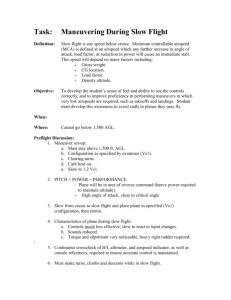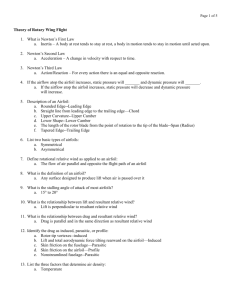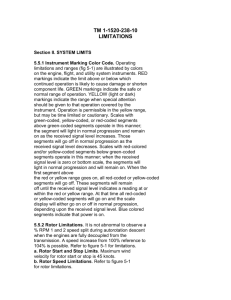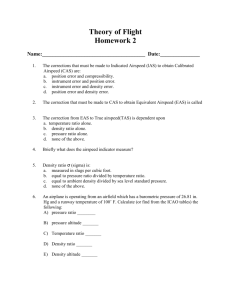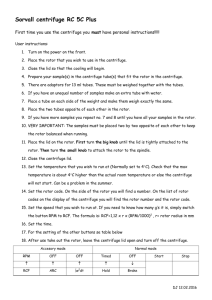Aero Question Bank
advertisement
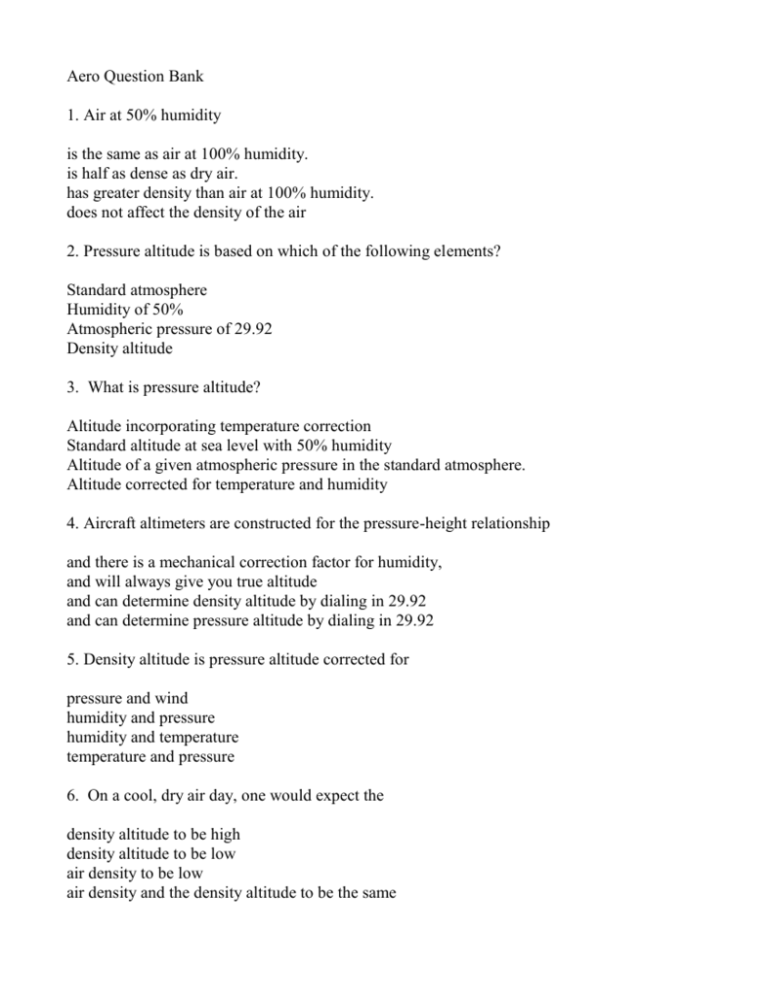
Aero Question Bank 1. Air at 50% humidity is the same as air at 100% humidity. is half as dense as dry air. has greater density than air at 100% humidity. does not affect the density of the air 2. Pressure altitude is based on which of the following elements? Standard atmosphere Humidity of 50% Atmospheric pressure of 29.92 Density altitude 3. What is pressure altitude? Altitude incorporating temperature correction Standard altitude at sea level with 50% humidity Altitude of a given atmospheric pressure in the standard atmosphere. Altitude corrected for temperature and humidity 4. Aircraft altimeters are constructed for the pressure-height relationship and there is a mechanical correction factor for humidity, and will always give you true altitude and can determine density altitude by dialing in 29.92 and can determine pressure altitude by dialing in 29.92 5. Density altitude is pressure altitude corrected for pressure and wind humidity and pressure humidity and temperature temperature and pressure 6. On a cool, dry air day, one would expect the density altitude to be high density altitude to be low air density to be low air density and the density altitude to be the same 7. When computing density altitude, SOON relative burn idity adds_____ to dry air density altitude 50% of the pressure altitude 500 ft plus 25% of the humidity 50 ft 500 ft 8. As temperature increases above standard day conditions, density altitude increase remain the same decrease fluctuate rapidly 9. As density altitude increases, the ______ will increase because the________is/are less efficient power available... rotor blades power required ... engine power available ... engine power required ... rotor blades 10.An increase in air density will increase density altitude have no effect on the helicopter below its hovering ceiling increase power available decrease rotor efficiency 11. What is the resultant of the vertical component (induced flow) and the horizontal component (linear flow)? Flight path Aerodynamic force Coning angle Relative wind 12. In a rotating system, the linear flow is ______ at the tip of the blade and __________ at the root. constant ... varying uniform ... irregular greatest ... least least ... greatest 13.As induced flow decreases, the angle-of-attack increases decreases remains the same cannot be determined 14.Induced flow is perpendicular to the tip-path while linear flow is parallel to the relative wind perpendicular to the tip-path plane parallel to the tip-path plane perpendicular to the relative wind 15. Within its envelope, when there is an increase in the angle-of-attack, there is a corresponding increase in the pitch angle lift linear flow induced flow 16. Induced drag is created as a result of the production of the plane of rotation. thrust ... lifting forces lift ... pro-autorotative forces lift ... decelerating forces thrust ... anti-rotative forces 17. Power required to rotate a rotor system is directly proportional to inertia power available momentum in-plane drag 18. The major forces acting on the rotor blades are centrifugal and aerodynamic centrifugal force and drag lift and drag weight and centrifugal 19. What two forces determine coning angle? G-loading force and centralization Aerodynamic force and lift Aerodynamic force and centrifugal force In-plane drag and g-loading force 20. What will happen to the fuselage when you add power? Yaw to the right due to torque effect Yaw to the right due to anti-torque Yaw to the left due to anti-torque Yaw to the left due to torque effect 2 1. In a single rotor helicopter, movement of the directional control pedals will vary rpm of the tail rotor vary the collective pitch of the tail rotor blades tilt the tail rotor control the aircraft movement about the pitch axis 22.Which of the following function(s) does the tail rotor serve? To control the aircraft about the lateral axis As an anti-torque device Both A and 8 above To control the aircraft about the pitch axis 23.A system having an even number of rotor systems of the same mass and design rotating in opposite directions is not as efficient as tail rotor helicopters cannot control movement about the vertical axis is effective because the rotor systems operate at different speeds is effective since both torque effects balance each other out 24.When making a vertical takeoff, what will happen to the tail rotor power requirements? Remain the same Increase Decrease Fluctuate rapidly 25.During a no-wind hover, a pedal turn to the ___________ in the TH-57 would cause the tail rotor to demand _________ power. right ... less right ... more left ... less right ... the same 26.At Cruise airspeed the rudder pedals are approximately even as tail rotor loading decreases due to: linear flow increasing across the advancing blade wind and horizontal stabilizer weather vaning and the vertical stabilizer vertical stabilizer 27.Since the tail rotor is a thrust producer, in what direction does the tail rotor cause the helo to drift? Left Right Forward Backward 28.With an engine loss in a hover, the pilot must move the ________ to the ___________ when the failure occurs as the tail rotor effect is eliminated. collective. . . up position collective ... down position cyclic ... left cyclic ... right 29. The main rotor is tilted to the __________ in order to counter the effect of the tail rotor, thus the helicopter will tend to take off _____________ skid first. left ... right right ... left left ... left right ... right 30. The virtual axis of a rotor system remains perpendicular to the relative wind tip-path plane mechanical axis in-plane thrust 31. Geometric twist on a rotor blade is limited due to its negative characteristics in which of the following situations? Hovering flight Flaring Ground effect Autorotation 37. Rotor blade "pitching moments" are minimized by using a __________ airfoil. tapered non-symmetrical neutral stability symmetrical 38. In order to tilt the rotor disc forward, blade pitch must decrease at the _____ and increase at the ____ positions. 270 90 180 360 360 180 90 270 39. During the initial phases of dis-symmetry of lift, the resulting flapping effect, the retracting blade feels decreasing linear flow, thus decreasing ______and decreasing aerodynamic force causing the blade to flap ______ . induced flow ... down AOA ... UP AOA ... down Induced flow... up 40.Dis-symmetry of lift is eliminated in a fully articulated rotor head by horizontal hinge pins vertical hinge pins blade dampers underslung mountings 41. What effect does airspeed have on rotor blade flapping? No effect Increased airspeed increases flapping Increased airspeed decreases flapping Decreased airspeed increases retreating blade 'flapping 42.What statement reflects blade flapping in forward flight? Affects the pitch angle on the blades Compensates for geometric imbalance Corrects for blade imbalance Varies the angle of attack on the blades 43.Because of the effects of the blowback while accelerating in forward flight, what must you do to maintain a level flight attitude? Hold the cyclic constant Trim in nose up Trim in nose down Yaw the helicopter and reduce lag 44.Flapping action of rotor blades while transitioning to forward flight will decrease with increases in airspeed decrease rotor trust increase collective pitch cause blowback 45.What will occur when the centers of mass in the rotor blades are at different radii to die mechanical axis? Geometric imbalance Geometric precession Flapping Gyroscopic precession. 46.Which of the following statements is characteristic of geometric imbalance in the semi-rigid rotor system? Cannot be eliminated due to the spanwise rigidity of the blades Is compensated by adjustment of the blade root counter weights, Is nearly eliminated by aligning the blade's center of mass- with the center line of the flapping hinge Is compensated through the alignment of the blade's centers of pressure and the rocking hinge 47.Translational lift increases available lift due to: increased linear flow decreased linear flow increased mass flow increased induced flow 48.One phenomena which decreases power required while hovering in ground effect is: reduction of vortices effect increased linear flow reduction of linear flow flapping 49.When first transitioning into forward Right the aircraft will settle because of reduced induce How transverse flow rotor vortices reduced linear flow Given a plot of power available and required versus velocity, which of the following statements is characteristic of maximum rate of climb velocity It is that velocity that corresponds to the point on the power required curve where a line drawn from the original becomes a tangent. It is that velocity where, there is maximum fuel consumption. It is that velocity corresponding to range. It is that velocity where there is maximum excess power. 51. The lateral vibration as a rotor system goes into forward flight is caused by transverse flow ground resonance induced drag blade flapping 52. As the helicopter arrives within one rotor diameter's distance of a smooth surface relative wind comes more horizontal due to a/an: increase in linear flow decrease in induced flow decrease in linear flow increase in induced flow 53. Ground effect increases with an increase in airspeed decreases with an increase in airspeed is not affected by airspeed is most effective when greater than one rotor diameter from the ground 54. Ground effect is caused by &/an: decrease in induced flow and decrease in wing tip vortex rings increase in induced flown and decrease in wing tip vortex rings decrease in induced flow and increase in wing tip vortex rings increase in induced flow and increase in wing tip vortex rings 55. The induced flow in an autorotation is: perpendicular to the relative wind perpendicular to the induced drag same as in powered flight reversed from powered -flight 56. What is the self-induced rotation of a rotor system in unpowered flight? Autorotation' Inertia Autogyration Rotary flight 57. If the resultant aerodynamic force vector of a blade is forward of the vertical, then the blade element is: aerodynamically stalled pro-autorotative experiencing translational lift in ground effect 58. When the pro-autorotative forces equal in-plane drag, the rotor RPM will be: fluctuating decreasing increasing stabilizing 59. The force which enables the pilot to regain RPM during autorotative flight is: momentum anti-autorotative force pro-autorotative force inertia 60. Anti-autorotative force _____when the pilot _____ the collective in autorotative flight. increases ... lowers does not change ... lowers decreases . . . raises decreases ... lowers 61.During the transitions to unpowered flight, ____ maintains rotor speed until induced flow is fully reversed. action/reaction induced drag inertia centrifugal force 62.In order to transition from powered to unpowered flight you must do which, if any, of the following actions? Reduce induced flow, reverse drag. regain and maintain RPM Reduce induced flow, reduce in-plane drag. regain and maintain RPM C Reduce in-plane drag. regain and maintain RPM Reduce induced flow, reverse in-plane drag, regain and maintain RPM 63. During an autorotation, the inner section of the rotor system will be _____ due to the _____ . anti-autorotative ... large linear flow pro-autorotative ... large induced flow stalled ... excessive angle of attack pro-autorotative ... large angle of attack 64. During the flare at the end of an autorotation the ____ flow vector which increases lift, slows airspeed and increases RPM. linear ... decreases linear ... increases induced ... increases induced ... decreases 65. An autorotative flare will increase rotor RPM and decrease A/S and rate of descent engine RPM and rate of descent engine Ng and rate of descent A/S and engine RPM 66. Two factors that affect autorotative rate of descent are: density altitude and airspeed airspeed and rotor RPM rotor RPM and density altitude density altitude and gross weight 67.Rotor speeds above the optimum RPM will cause an increase in the rate of descent will cause a decrease in the rate of descent will not effect rate of descent will not improve the range that can be traveled 68. Concerning the height-velocity (h.v.) diagram, what conditions should be avoided? Low altitude, slow airspeed High gross weight and density altitude High airspeed at altitude Low altitude high airspeed 69. What is the lowest point on the power required versus airspeed curve? Max endurance airspeed Max range airspeed Max glide airspeed Maximum fuel consumption 70.Increases in helicopter weight cause what reaction? An increase of power required at all airspeeds A reduction of power available An increase in power available An increase of maximum excess power 72. Which of the following actions should NOT be the pilot's reaction if the aircraft experiences a sudden nose up pitch while flying at high airspeeds? Increase RPM Down collective Forward cyclic Jettison external load 73. An increase in density altitude has no effect on maximum endurance airspeed has a significant effect on maximum endurance airspeed will cause decrease in power required will not effect power required 74. _____ in Nr will _____ the airspeed at which you will reach retreating blade stall. An increase ... decrease A decrease ... increase An increase ... increase A decrease. . . not effect 75.Some of the cockpit indications during vortex ring state are high Ng, high TOT, low Nr, low Nf high descent rate, low airspeed, high Ng normal Ng, high descent rate, normal Nr, low airspeed high TOT, low airspeed, high descent rate 76.When does vortex ring state take place? When power required exceeds power available When power available exceeds power required When retreating blade stalls When aircraft settles in its own vortex If vibrations and loss of control response occurs during a steep, low airspeed approach, the pilot should immediately take what action (s)? Jettison external loads Lower collective slightly, apply aft cyclic Apply forward cyclic, raise collective slightly Lower collective, forward cyclic 78.With cockpit indications of increased rate of descent, high Ng, high TOT, and decaying Nr, the pilot is experiencing retreating blade stall vortex ring state power required greater than power available excessive blade flapping 79.If settling is encountered with a reduced airspeed at maximum power, what should be regained to insure level flight? Original power Original torque Original airspeed Original angle-of-attack 80.Your aircraft is power required greater than power available. Placing the collective down will decrease the rate of descent at that airspeed intensify the vortex ring state reverse the airflow, reduce the in-plane drag, and stop the rate of descent increase the rate of descent 81. A destructive vibration occurring in the rotor system when the aircraft is in contact with the ground is blade flapping ground effect geometric imbalance ground resonance 82.During a ground resonance, if unable to takeoff, the pilot should shut down engine and apply rotor brake rum aircraft into the wind shift center of gravity of aircraft back to normal hold the collective down 83.While in a hover, the helicopter enters uncontrolled leftward flight even though the pilot has applied full right cyclic, the helicopter may be entering ground resonance be experiencing dynamic rollover have entered geometric imbalance have exceeded led center of gravity limitations 94.Wingtip vortex intensity is not affected by lift angle-of-attack weight parasite drag 85.Rotor tip vortices are a function of the density altitude created by high pressure air above the airfoil flowing to low pressure area beneath it created by low pressure air below the airfoil flowing to high pressure area beneath it created by high pressure air below the airfoil flowing to low pressure area above it 86.Helicopter "A" weigh 12,000 lbs. and helicopter "B" weighs 23,000 lbs. Which, if any, of the aircraft produces more intense rotor tip vortices? Helicopter "A" Helicopter "B" There is no difference Not enough information given to answer the question 87.Which of the following characteristics best describes powered flight best range airspeed? Unaffected by wind Greatest distance traveled for the least fuel burned Higher with prevailing tail wind Maximum excess power 88.Powered flight best range airspeed will be constant for a given helicopter increase with a head wind be directly proportional to power available decrease with a head wind 89. What are two essential elements for dynamic rollover to occur? Vertical force and ground pivot point Side force and ground pivot point Pitching moment an a loss of tail rotor authority Lateral force and an articulated rotor head 90. Which of the following sources may contribute to the rolling tendency during dynamic rollover? Flapping Geometric imbalance Tail rotor side force Aft center of gravity 91. Which of the following actions contribute to mast bumping? Small rapid cyclic movements Unbalanced flight conditions Low G maneuvers Flight at low density altitudes 92. What is the corrective action if you experience mast bumping during a low G maneuver? Smoothly center cyclic and lower collective Smoothly apply aft cyclic and center Smoothly apply left pedal input and center cyclic Smoothly center and apply forward cyclic 93. A _ frequency vibration is caused by high ... loose aircraft components - medium medium ... the tail rotor medium ... the drive shaft low ... the main rotor 94. Excessive lateral one to one vibrations are caused by _____ 2 to 1 A loose aircraft component A tail rotor malfunction An engine malfunction An imbalance in the main rotor 95. During a hovering right turn, you may experience a sudden uncommanded right yaw caused by Main rotor vortices Increased tail rotor angle-of-attack Sudden left peddle inputs CG being located a the forward limit


